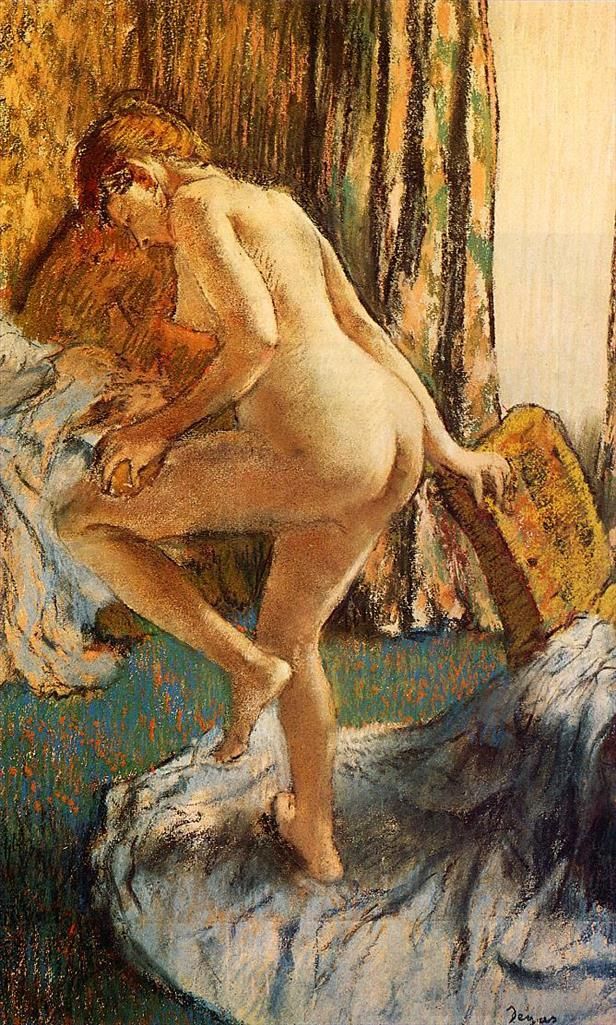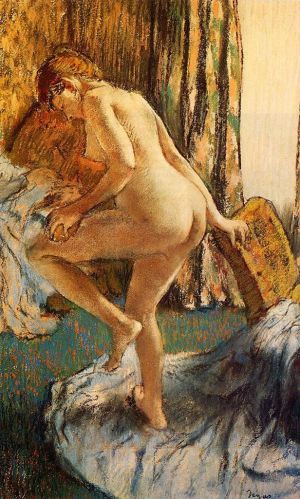After the Bath
Edgar Degas
- Price: Price on Request
- Art Type: Various Paintings
- Size:
- English Comments: 0
- International Comments: 0
- Creating Date:
- Introduction and Works of Edgar Degas >>
Keywords:
Bath
Work Overview
- After the Bath
Edgar Degas
Date: c.1883
Style: Impressionism
Genre: nude painting (nu)
Media: pastel
Nude figures are central to the work of Edgar Degas (1834-1917), from his early works in the first half of the 1850s to the final years of his artistic activity on the eve of the First World War. Even more than the dancers, the scenes of horse racing and urban life, or the portraits that made him famous, the nude was the genre Degas used to introduce new ideas and develop his style over the course of almost fifty years.
Degas was noted for his innovative temperament, which expressed itself in many different areas. The works brought together here have been selected because they show the variety of techniques that Degas tackled in his search for new expressive possibilities.
In addition to drawing and painting, the artist was particularly fond of pastel as it could be used spontaneously with no preparation or drying time, giving him the option to rework the image. Degas was also renowned for having rediscovered the principle of the "monotype", a print that does not require engraving, which he sometimes highlighted with pastel. He also tried his hand at etching, lithography and particularly at sculpture, which increasingly occupied him as his sight failed in the late 1880s.
And so this first monographic exhibition devoted to the nude enables us to trace the whole of the artist's career, through all the media he used, from his early academic training to his most radical and simplified figures, and including his Naturalist years. Degas no longer put forward an idealised nude, but rather a representation of the naked body, unheard of until then. This exhibition also places Degas' work in the context of the time when it was created, through a selection of works produced during his lifetime by artists who influenced him (Ingres, Delacroix), those who worked at the same time (Caillebotte, Renoir) or those he inspired (Matisse, Picasso).
This exhibition aims to help explain why Degas occupies such an important place in the history of 19th century art, highlighting his ability to bring together the classical culture of his era and the avant-garde movements of the 20th century, through works that are seldom exhibited together because of their fragility and their diversity.
- Copyright Statement:
All the reproduction of any forms about this work unauthorized by Singing Palette including images, texts and so on will be deemed to be violating the Copyright Laws.
To cite this webpage, please link back here.
- >> English Comments
- >> Chinese Comments
- >> French Comments
- >> German Comments
- >>Report
- The Dance Class
- Portrait of the Painter Henri Michel Levy
- The Rehearsal
- The Rape
- Edmond and Therese Morbilli
- Before the Race2
- Ballet Rehearsal
- At the Milliner s
- Singer with a glove (Café Singer)
- Head of a Young Woman
- At the Races Before the Start
- Four Dancers
- At the Milliners 2
- The Ballet Class
- The Star
- Woman Ironing 1884
- At the Races in the Countryside (A Carriage at the Races)
- Portrait after a Costume Ball Portrait of Madame DietzMonnin
- Beach Scene
- A Roman Beggar Woman
- A Carriage at the Races
- Degas in a Green Jacket
- Henri De Gas and His Neice Lucie Degas
- Dancer At The Photographers
- Ballerina and Lady with a Fan
- Self Portrait
- At the Races the Start
- At the Milliners
- Achille De Gas in the Uniform of a Cadet
- The Millinery Shop
- Interior aka The Rape
- In a Café (Glass of Absinthe or The Absinthe Drinker)
- Diego Martelli
- Cotton exchange
- Ballet at the Paris Opera
- Edmond Duranty
- The Star (Ballet or Dancer on Stage)
- Hortense Valpin
- The Dancing Class
- Dancers in Pink
- The Bellelli Family (Family Portrait)
- At the Milliners 3
- At the Races
- Cafe concert
- Portrait of Mary Cassatt
- The Parade (Race Horses in front of the Tribunes)
- Woman ironing
- Ballet Class
- Emma Dobigny
- CAFÉ CONCERT AT LES AMBASSADEURS
- The Duke and Duchess Morbilli
- The Rehearsal of the Ballet Onstage
- Dancer at the Barre circa 1880
- At the Mirror
- After the Bath
- Study of Gentile bellini 1854
- After the Bath
- Before the Rehearsal 1880
- After The Bath
- The Tub
- After The Bath 1884
- Woman Combing Her Hair
- At the Ballet
- The Dance Examination
- Woman At Her Toilet
- After the Bath Woman Drying Herself
- Seated Dancer Adjusting Her Shoes









 Singing Palette
Singing Palette